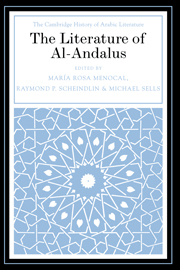Madīnat al-Zahrāʾ and the Umayyad palace
from 1 - Visions of al-Andalus
Published online by Cambridge University Press: 28 May 2012
Summary
A palm tree stands in the middle of Rufṣāfa, born in the West, far from the land of palms. I said to it: “How like me you are, far away and in exile, in long separation from family and friends. You have sprung from soil in which you are a stranger; and I, like you, am far from home.”
The power of this verse, establishing ʿAbd al-Raḥmān’s roots in Syria and his success in al-Andalus, has reached subsequent historians, generations of whom have repeated the poem as proof of an ideological and cultural bridge between Syria and the Iberian Peninsula. It reminds us that the first emir of al-Andalus named his palace outside Córdoba for Ruṣāfa, the estate in Syria where he had spent his youth, and thus links the masculine enterprises of palace building and empire building.
The Umayyads of Córdoba were genetically and culturally the progeny of Muslim Arab fathers. Through a variety of visual and performative signs, they presented themselves entirely as Arab and Muslim, the sons of a pure, uncomplicated patriarchal genealogy. But their mothers were for the most part Christian, often of slave origin or won in diplomatic exchanges. The world of the chroniclers, imams, calligraphers, and architects was peopled largely by men – but family life, where the children were reared until daughters were sent in marriage and sons stepped into the public eye, was ruled by women. Nowhere were the intimate ties binding the ethnic and religious groups that comprised Andalusian culture more evident and more profound than in the domestic arena of the harem. The emirs, caliphs, and sultans who ruled al-Andalus grew up in the secluded family quarters of the royal palaces such as Madīnat al-Zahrāʾ in tenth-centuryCórdoba.
- Type
- Chapter
- Information
- The Literature of Al-Andalus , pp. 25 - 30Publisher: Cambridge University PressPrint publication year: 2000
- 4
- Cited by

